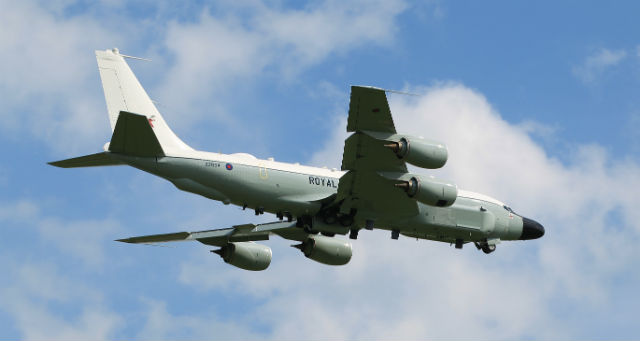A new series of flight tests involving an ageing Boeing KC-135 tanker will help to inform the UK Ministry of Defence about whether the aircraft will be able to secure full operational clearance as a converted signals intelligence asset.
The Royal Air Force’s first RC-135W Rivet Joint aircraft entered use earlier this year under the UK’s Airseeker acquisition, with another two due to be delivered in mid-2015 and during 2017.
Training activities with lead aircraft ZZ664 started in May from RAF Waddington in Lincolnshire using an initial release-to-service approval for its 51 Sqn. It was then swiftly called on to make its operational debut, gathering intelligence data about militant activity in northern Iraq while flying out of RAF Akrotiri in Cyprus.

Crown Copyright
The UK’s third Rivet Joint airframe arrived at L-3 Communications’ Greenville site in Texas in July, where it will take part in a five-month series of flight-testing before its modification for the new role, the UK Defence Equipment and Support (DE&S) organisation reveals in its Desider publication.
A US Air Force RC-135W is also to participate in the activity, which is intended to provide the allies with “crucial flight performance information”, the DE&S report says.
“This programme will provide the UK with much-needed information to enable some aspects of the aircraft’s flight envelope to be validated. This will augment the limited availability of historical flight test information and enable a full release-to-service clearance of the USAF flight envelope to be considered,” it adds.
Another objective is for the USAF to “collect detailed flight performance information that will be used to improve the fidelity of their dynamic simulators and so reduce the dependence on live flying”, DE&S says. The service operates a fleet of 17 RC-135V/Ws, as recorded by Flightglobal’s MiliCAS database.
DE&S says the RAF’s second modified aircraft should enter ground testing early in 2015, with its delivery expected “next summer”. Its final RC-135W – which will be registered as ZZ666 – is scheduled to enter its 30-month conversion process in January 2015, and to be delivered in 2017.
Source: FlightGlobal.com


























